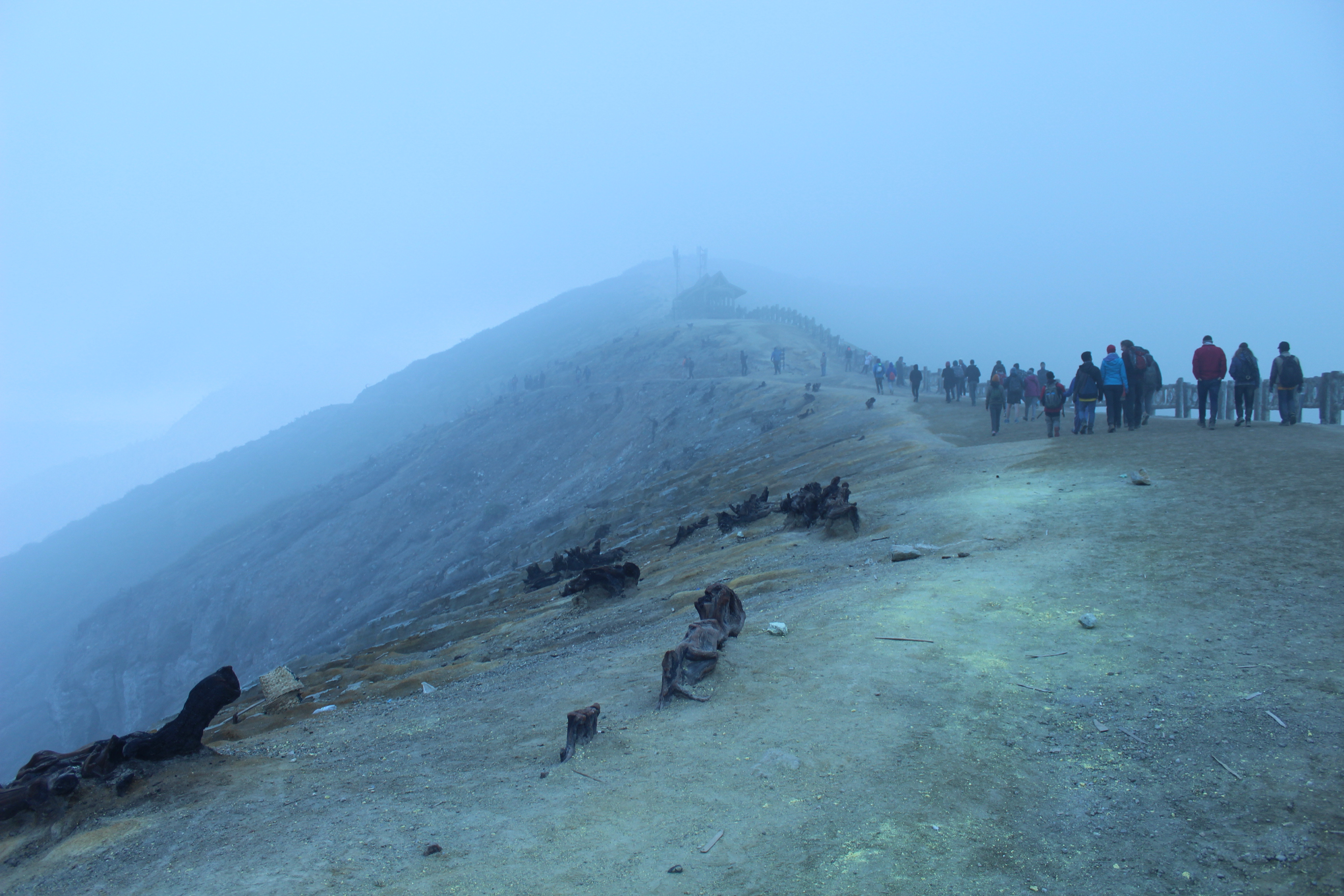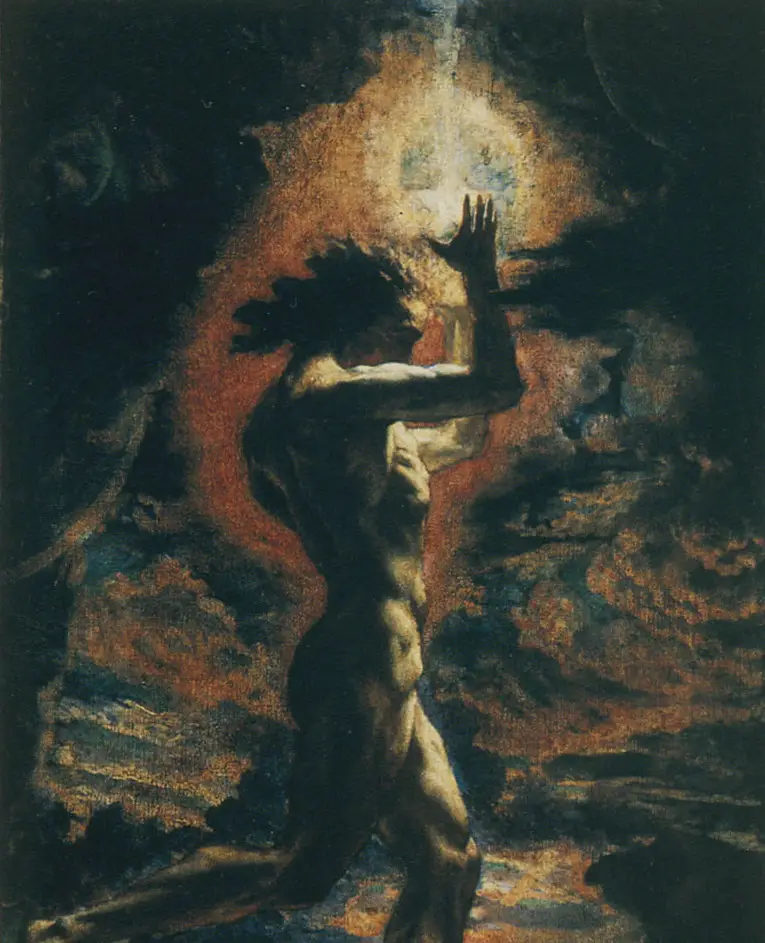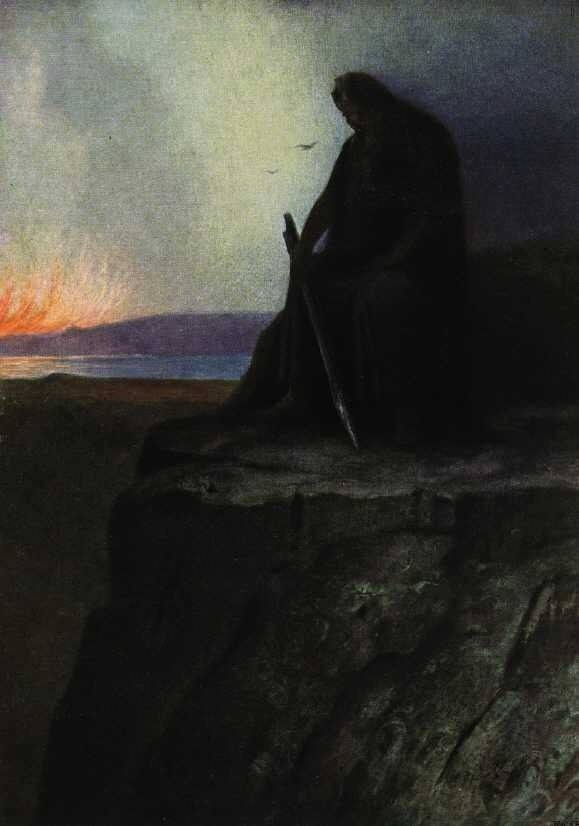Tag: Ade
Kawah Ijen: Hell & Heaven
We made an excursion, among the indigenous sulfur collectors, on the slopes of the only volcano in the world that erupts blue lava: the Kawah Ijen on the Indonesian island of Java. The nocturnal catabasis and the morning ascent, similar to those of Dante in Doré's illustrations, gave rise to meditations in us on the power of the cataclysmic events that have always affected the Pacific "belt of fire", and on the necessity on the part of the man to accept them and to come to terms with them.
The emanations of the "Dark Satellite"
Notes on the dark side of Selene symbolism, from Plutarch's "De facie in orbe lunae" to René Guénon and Stanislas de Guaita
The "Heavenly Fire": Kronos, Phaeton, Prometheus
di Andrew Casella
cover: Jean Delville, Prometheus, 1907)
[Continued from The astronomical significance of the Golden Age: Astrea and the "fall" of Phaeton]
In a Mongolian wedding prayer it is stated that: "Fire was born when Heaven and Earth separated": Therefore, before the celestial equator (Father Heaven) and the ecliptic (mother Earth) moved away (ie the inclination angle of about 23 ° of the ecliptic with respect to the equator was recorded), the" Fire " did not exist. At the beginning, the Milky Way united heaven, earth and the world of the dead: the southern part of the Galaxy, in correspondence with Scorpio and Sagittarius, is, for many traditions, the place dedicated to the collection of souls waiting to reincarnate.
The archaic substratum of the end of year celebrations: the traditional significance of the 12 days between Christmas and the Epiphany
di Marco Maculotti
article originally published on Atrium on 21/12/2016,
here revised and expanded
Here we aim to deepen the folkloric beliefs that have led to the configuration of two figures intimately connected to the liturgical-profane calendar of Europe in recent centuries. The two figures that interest us are those of Santa Claus (Italianized in Santa Claus) and of the Befana, figures that - as we will see - owe their origin and their symbolism to an archaic substratum, anthropologically recognizable in all those practices and beliefs (myths and rites) of the volk European (or rather eurasian), which elsewhere we have defined as "cosmic-agrarian cults" [cf. Cosmic-agrarian cults of ancient Eurasia].
Divinity of the Underworld, the Afterlife and the Mysteries
di Marco Maculotti
We continue the discussion previously developed, taking it from the connection that we have seen to exist, in ancient traditions, between the period of the "solstitial crisis" and the belief in the return of the souls of the dead to the living. The connection with the underworld / underworld and with the Kingdom of the Dead seems, as we have seen, to be recurrent for these deities that we have defined as 'of the Winter Sun' [cf. Cernunno, Odin and other deities of the 'Winter Sun'], at the same time gods of fecundity and also linked to the underworld and, therefore, to the deceased.
We have already seen that the Celtic Cernunno, in addition to being a god of nature and time, is also considered an underworld deity, especially as regards his psychopomp function, as a companion of the dead in the afterlife: a mercurial aspect that in tradition Nordic is also found, as we have seen, in Odin / Wodan, from which in fact derives the day of the week which Latin belongs to Mercury (Wednesday= “Wodan's days"). Likewise, in many traditions from all over the world there are numinous figures connected both with fertility and with the Underworld and the Underworld, starting with the Mediterranean Lord of Hades Pluto, among whose symbols there is the cornucopia (*krn), conveying abundance, fertility, wealth.
Cernunno, Odin, Dionysus and other deities of the 'Winter Sun'
di Marco Maculotti
cover: Hermann Hendrich, "Wotan", 1913
[follows from: Cosmic cycles and time regeneration: immolation rites of the 'King of the Old Year'].
In the previous publication we had the opportunity to analyze the ritual complex, recognizable everywhere among the ancient Indo-European populations, centered on theimmolation (real or symbolic) of the "King of the Old Year" (eg. Roman Saturnalia), as a symbolic representation of the "Dying Year" that must be sacrificed to ensure that the Cosmos (= the order of things), reinvigorated by this ceremonial action, grants the regeneration of Time and of the 'World' (in the Pythagorean meaning of Kosmos like interconnected unit) in the new year to come; year which, in this sense, becomes a micro-representation of the Aeon and, therefore, of the entire cyclical nature of the Cosmos. Let's now proceed toanalysis of some divinities intimately connected with the "solstitial crisis", to the point of rising to mythical representatives of the "Winter Sun" and, in full, of the "King of the Waning Year": Cernunno, the 'horned god' par excellence, as far as the Celtic area is concerned; Odin and the 'wild hunt' for the Scandinavian one and Dionysus for the Mediterranean area.
Metamorphosis and ritual battles in the myth and folklore of the Eurasian populations
di Marco Maculotti
The zoomorphic metamorphosis topos is widely present in the folkloric corpus of a large number of ancient traditions, both from archaic Europe (on which we will focus mainly in this study), and from other geographical areas. As early as the fifth century BC, in Greece, Herodotus mentioned men capable of periodically transforming themselves into wolves. Similar traditions have been documented in Africa, Asia and the American continent, with reference to the temporary metamorphosis of human beings in fairs: bears, leopards, hyenas, tigers, jaguars. Sometimes, in some historically documented cases of the ancient world (Luperci, Cinocefali, Berserker) "The paranormal experience of transformation into an animal takes on collective characteristics and is at the origin of initiatory groups and secret societies" (Di Nola, p.12).








